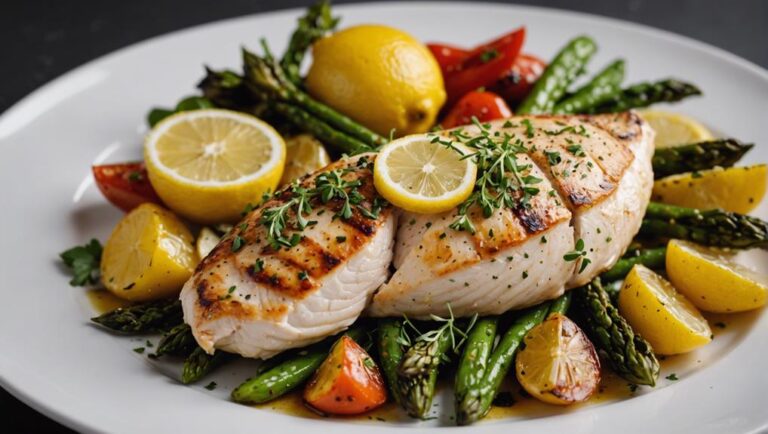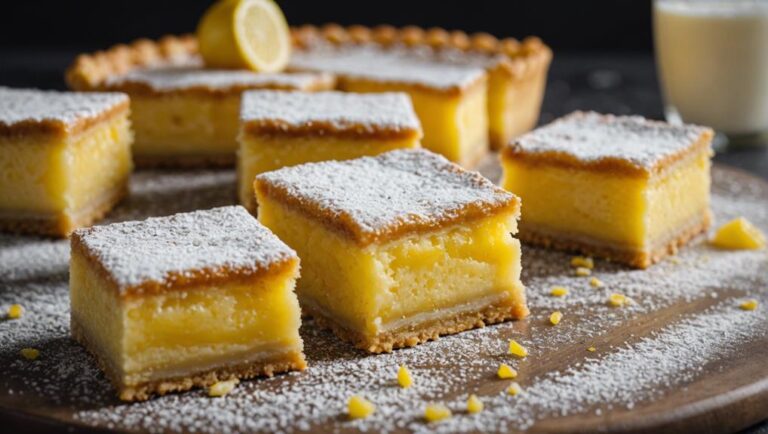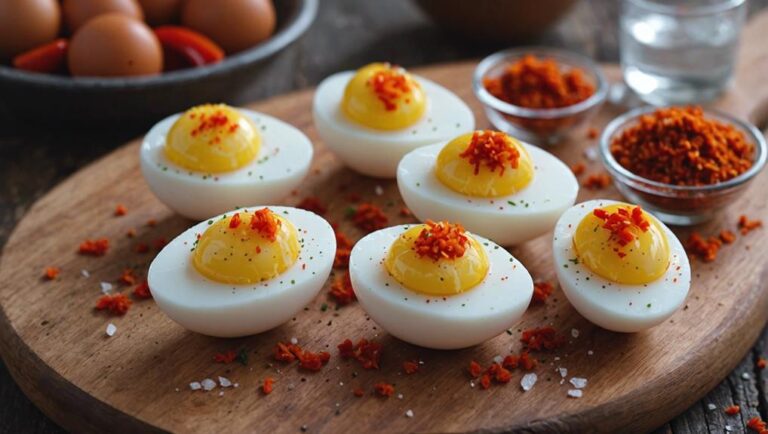Sous Vide Mashed Parsnips
Enhance the texture and flavor of your mashed parsnips using sous vide techniques. Achieve a consistent and creamy result by maintaining precise temperature control. This process guarantees even cooking throughout, resulting in a delightful culinary experience. The low starch content of parsnips creates a smoother consistency when mashed. By adding cream, butter, salt, and pepper, you enrich the flavors of this root vegetable dish. Experiment with different seasonings to customize it according to your preferences and elevate the dish further. Enjoy the benefits of sous vide cooking for a perfect mashed parsnip dish.
What You Will Learn Here
- Sous vide cooking enhances the creamy texture and flavor of mashed parsnips.
- Precise temperature control ensures even cooking for a smoother consistency.
- Low starch content in parsnips contributes to a silky smooth texture.
- Additional ingredients like cream, butter, salt, and pepper enrich the flavor.
- Easily customizable with various seasonings for a personalized touch.
Root Vegetable Origins

Parsnips, originating in Eurasia, hold a significant place in the history of root vegetables. Their cultivation dates back to ancient times, showcasing a long-standing presence in human diets.
The evolution of parsnips in culinary practices reflects the versatility and adaptability of these nutrient-rich vegetables.
Root Vegetable Origins
Originating from Eurasia, root vegetables like parsnips have a long history of cultivation dating back thousands of years. These underground treasures not only provide a rich source of nutrients but also offer a diverse range of flavors and textures. The table below highlights some common root vegetables and their key characteristics:
| Root Vegetable | Characteristics |
|---|---|
| Carrots | Sweet, crunchy |
| Potatoes | Starchy, versatile |
| Beets | Earthy, vibrant color |
| Turnips | Peppery, robust |
| Radishes | Spicy, crisp |
Each of these vegetables brings a unique profile to the table, making them essential ingredients in various cuisines worldwide.
Historical Background
With a rich history dating back centuries, root vegetables like parsnips have played a significant role in the culinary landscape of various regions. Parsnips, known for their hardiness and nutritional benefits, have been cultivated since Roman times. Their cultivation spread to Europe, Asia, and later to North America in the 17th century, becoming a staple in colonial diets.
The sweet, earthy flavor of parsnips made them a favorite ingredient, adaptable to various climates. Root vegetables, including parsnips, were valued for their long storage life and versatility in cooking methods.
Today, sous vide parsnips offer a modern twist on traditional recipes, providing a new way to enjoy the flavors and nutrients of this ancient root vegetable by cooking them gently in a vacuum-sealed bag.
Culinary Evolution
Evolving over centuries, root vegetables have been integral to the culinary landscape, providing essential nutrients and diverse flavors. Parsnips, a member of the carrot family, have a rich history dating back to Eurasia, where they were cultivated by ancient civilizations like the Romans and Greeks.
These vegetables gained popularity in medieval Europe and colonial America, evolving from basic sustenance to culinary delicacies. With advancements like the Sous Vide Precision Cooker, parsnips have undergone a culinary transformation, becoming a gourmet ingredient in modern cooking practices.
Their sweet and earthy flavor profile has made them a versatile choice for dishes, showcasing how root vegetables have adapted and flourished in the ever-changing culinary world.
Parsnip Varieties

Exploring the diverse flavors of parsnip varieties reveals distinct nuances in sweetness, earthiness, and nuttiness that influence culinary choices. When selecting parsnips for your dishes, consider the following points:
- Gladiator Variety: Known for its robust sweetness, this variety is excellent for roasting or mashing, adding a delightful caramelized flavor to your dishes.
- Hollow Crown Variety: With a more earthy undertone, this type of parsnip is perfect for soups and stews, infusing a deep, rich flavor into your culinary creations.
- Cobham Marrow Variety: Offering a nuttier profile, these parsnips are great for purees or as a side dish, providing a unique taste that complements a variety of main courses.
- High-Sugar Varieties: Specifically bred for their sweetness, these parsnips are ideal for caramelizing or incorporating into desserts, bringing a natural sugary element to your sweet treats.
Understanding the characteristics of different parsnip varieties allows you to enhance the flavors and textures of your dishes, catering to your specific culinary preferences.
Tasty Parsnip Dishes
You can explore a range of tasty parsnip dishes like Sous Vide Parsnip Fries, Parsnip Puree With Maple Glaze, and Sous Vide Parsnip Ribbons.
These dishes offer unique textures and flavors that showcase the versatility of parsnips in culinary applications.
Experimenting with different cooking techniques and flavor combinations can elevate the humble parsnip into a delightful and satisfying dining experience.
Sous Vide Parsnip Fries
For a nutritious and flavorful twist on traditional fries, consider preparing Sous Vide Parsnip Fries, a delectable and health-conscious alternative. Parsnips, rich in fiber, vitamins, and minerals, make them a nutritious choice for a side dish. Cooking parsnip fries sous vide guarantees even cooking and a perfect tender texture. Season parsnip fries with your favorite herbs and spices before cooking for added flavor. Serve crispy sous vide parsnip fries as a tasty snack or side dish for any meal.
- Sous Vide Parsnip Fries are a delicious and healthier alternative to traditional potato fries.
- Parsnips are rich in fiber, vitamins, and minerals, making them a nutritious choice for a side dish.
- Cooking parsnip fries sous vide guarantees even cooking and a perfect tender texture.
- Season parsnip fries with your favorite herbs and spices before cooking for added flavor.
Parsnip Puree With Maple Glaze
Parsnip puree with maple glaze combines the earthy sweetness of parsnips with a delightful touch of maple to create a flavorful side dish perfect for fall or winter meals. When prepared sous vide, this dish offers a unique depth of flavor and a velvety texture that's sure to impress. The controlled temperature in the bag guarantees that the parsnips are cooked evenly and retain their natural sweetness.
Here are some key points to take into account when making Parsnip Puree With Maple Glaze:
- Sous vide cooking method enhances flavor infusion.
- Maple glaze caramelizes beautifully, adding a rich taste.
- The earthy notes of parsnips are complemented by the sweet maple.
- The dish offers a creative twist on traditional purees.
Sous Vide Parsnip Ribbons
Utilizing the sous vide cooking method for parsnip ribbons guarantees precise and even cooking, preserving their shape and enhancing their flavor profile. When preparing sous vide parsnip ribbons, consider the following:
- Create visually appealing ribbons by using a vegetable peeler to slice thin, long strips of parsnips.
- Season the parsnip ribbons with herbs, spices, or citrus zest before sous vide cooking to enhance their taste.
- Sous vide cooking ensures that the ribbons are cooked evenly, resulting in a consistent texture throughout.
- Serving these elegant parsnip ribbons as a side dish or garnish can elevate the presentation of your meal, adding a touch of sophistication to your culinary creations.
Sous Vide Timing Tips
To achieve the perfect sous vide mashed parsnips, it's important to adhere to the recommended cooking times and temperatures provided.
Precision in maintaining the set temperature range of 183°F to 185°F is essential for ideal results.
Understanding the benefits of par-cooking and adjusting timing based on desired texture will help you master the art of sous vide mashed parsnips.
Cooking Time Recommendations
When aiming for ideal cooking results in sous vide preparation, maintaining a consistent temperature throughout the 1.5-hour duration is crucial for achieving perfectly cooked mashed parsnips. Set your sous vide water bath to 190°F (87°C) and let the parsnips cook for the recommended time to guarantee a smooth and flavorful outcome. The table below outlines the cooking time recommendations for achieving the best results:
| Temperature (Fahrenheit) | Temperature (Celsius) | Cooking Time |
|---|---|---|
| 190°F | 87°C | 1.5 hours |
| 185°F | 85°C | 2 hours |
| 200°F | 93°C | 1 hour |
Following these precise time and temperature guidelines will ensure delicious, creamy mashed parsnips every time.
Temperature Precision Importance
For peak results in sous vide cooking, maintaining precise temperature control is paramount to guarantee consistent and perfect outcomes. The sous vide technique relies on water circulators like Anova to ensure accuracy by circulating water at a constant temperature, creating an ideal cooking environment.
Even minor temperature fluctuations can have a substantial impact on the texture and doneness of the food being prepared. Temperature precision is essential for achieving ideal texture, flavor infusion, and tenderness in sous vide dishes.
To excel in sous vide cooking, it's essential to adhere to recommended temperature guidelines for different ingredients, as this precision is the key to maximizing the full potential of your culinary creations.
Mastering temperature control with a reliable water circulator is the cornerstone of successful sous vide cooking.
Par-Cooking Benefits
Par-cooking parsnips sous vide style contributes greatly to achieving precise temperature control and enhancing the texture and flavor of your mashed parsnips. When you pre-cook parsnips sous vide, you establish the foundation for a perfectly tender and flavorful mash. The sous vide method guarantees that the parsnips are evenly cooked throughout, resulting in a smoother and creamier consistency. This technique also helps to preserve essential nutrients in the parsnips, making your dish not only delicious but also healthier. Timing plays an important role in sous vide par-cooking; it determines the final tenderness of your mashed parsnips. By mastering the art of par-cooking sous vide, you can elevate your mashed parsnips to a whole new level of culinary excellence.
| Benefits of Sous Vide Par-Cooking | |
|---|---|
| Precise Temperature Control | Enhanced Flavor |
| Consistent Texture | Retained Nutrients |
| Smoother and Creamier Mash | Improved Health |
| Even Cooking Throughout | Culinary Excellence |
| Healthier Dish |
Final Thoughts
To recap, the sous vide method undeniably enhances the creamy and flavorful profile of mashed parsnips, providing a delightful alternative to traditional mashed potatoes. By employing the water immersion technique, you encounter cooking that guarantees precise temperature control, resulting in an ideal texture for the parsnip puree.
Parsnips, being lower in starch than potatoes, contribute to a smoother consistency in the puree, elevating the overall mouthfeel of the dish. The addition of cream, butter, salt, and pepper further enriches the flavor profile of the mashed parsnips, creating a decadent yet wholesome side dish.
Additionally, the versatility of this recipe allows for easy customization with additional seasonings to tailor the dish to your personal preferences. In summary, sous vide mashed parsnips offer a sophisticated and delicious option that's both comforting and satisfying, making it a standout dish for any occasion.
Frequently Asked Questions
Are Boiled Parsnips Good?
Boiling parsnips can be good as it softens them for various dishes. Roasting parsnips can enhance their flavor and texture. Pureed parsnips offer a smooth consistency. Experiment with different cooking methods to discover your preferred way of enjoying this versatile vegetable.
Is It OK to Soak Parsnips in Water?
It's absolutely okay to soak parsnips in water. This step helps in water absorption and can clean off dirt and pesticides. Just remember not to soak them too long to prevent waterlogging. Rinse well after soaking for the best results.
How Long Does It Take to Boil Parsnip?
When boiling parsnips, the cooking time varies based on size; typically taking 15-20 minutes until tender. Test doneness with a fork. Avoid overcooking to prevent mushiness. It's a quick, simple method, ideal for dishes like mashed parsnips.
Can You Sous Vide Vegetables?
Yes, you can sous vide vegetables to achieve ideal texture and flavor infusion. Sous vide cooking guarantees vegetables maintain their natural qualities, allowing for precise control over the cooking process, resulting in consistent and delicious outcomes.
Conclusion
To sum up, sous vide cooking offers a precise and controlled method for preparing mashed parsnips, ensuring a consistent and delicious result every time.
By understanding the origins and varieties of parsnips, as well as incorporating timing tips for sous vide cooking, you can create a flavorful and tender dish that will delight your taste buds.
Experiment with different seasonings and toppings to personalize your mashed parsnips and elevate your culinary experience.











